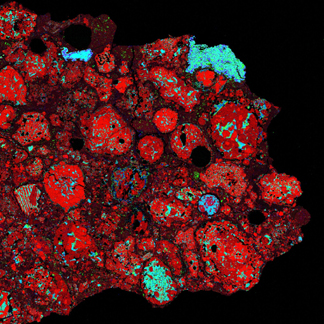Geotimes

Untitled Document

News Notes
Planetary Geology
Early Jupiter spawned early meteorites
 When
our solar system was forming, back when the sun was a mere whisper of its current
self and the planets were just bands of coalescing gas and debris, chondrules
were forming. Tiny mineral beads only millimeters across, these ancient grains
reside in the most primitive meteorites, and have confounded scientists for
a century. Their age is known, but their origin has been notoriously difficult
to determine. Now, researchers have generated a model of the early solar system
that suggests that Jupiter’s formation may have spawned chondrules.
When
our solar system was forming, back when the sun was a mere whisper of its current
self and the planets were just bands of coalescing gas and debris, chondrules
were forming. Tiny mineral beads only millimeters across, these ancient grains
reside in the most primitive meteorites, and have confounded scientists for
a century. Their age is known, but their origin has been notoriously difficult
to determine. Now, researchers have generated a model of the early solar system
that suggests that Jupiter’s formation may have spawned chondrules.
This X-ray thin section of a meteorite
shows the elemental composition of both chondrules — tiny ancient mineral
grains — and calcium-aluminum-rich inclusions. Red represents magnesium,
green is calcium, and blue is aluminum. These primitive materials may have formed
from shockwaves produced in the solar nebula. Courtesy of A. N. Krot, University
of Hawaii.
One of the leading theories for how chondrules and the solar system formed has
been that large shockwaves generated the necessary heat. But “what produces
shockwaves in the nebula” has been unknown, says Harold Connolly, an expert
on chondrule formation at Kingsborough College and the graduate school of the
City University of New York.
Along the spiraling arms of solar nebula material, pressure waves from the disk
of matter that was accumulating to form Jupiter may have formed the shockwaves,
report Alan Boss of the Carnegie Institution of Washington and Richard H. Durisen
of Indiana University in the March 10 issue of Astrophysical Journal Letters.
The team set up models to see what happens when a disk of materials massive
enough to form Jupiter is “turned loose,” Boss says.
The new 3-D model shows the chondrules as part of the larger evolution of the
solar system, from birth approximately 4.5 billion years ago until the early
sun had accreted most inner-nebula materials 3 million years later. The researchers
say that gravitational shockwaves from Jupiter’s formation may have provided
the flash heating necessary to melt iron- and magnesium-rich intra-stellar silicate
debris to form the tiny chondrule spherules.
Early studies suggested that the only way to melt the silicates in chondrules
in a manner consistent with meteorite observations would have been to heat the
grains to melting temperatures multiple times, a process that could be achieved
by shockwaves only if they are traveling at least 6 to 9 kilometers per second.
According to the new model, the swath of material that would become Jupiter
could have driven spiral shockwaves up to 10 kilometers per second, fast enough
to produce chondrules. And independent calculations by Durisen and his co-workers
seem to confirm that these waves would have caused chondrule-producing shocks
in the asteroid belt.
Chondrules, along with larger inclusions and microscopic matrix particles, are
the principal components of chondrites, the most primitive meteorites. The new
modeling suggests that not only did the shockwaves generate the necessary melting,
but that they also did so at a time when the earliest known crystalline materials,
calcium aluminum inclusions in meteorites, were forming — suggesting that
chondrules may be almost as old. The shockwaves would have continued for several
million years, as long as gas remained in the inner-nebula disk, suggesting
multiple heating events. “The key is the recent result that some chondrules
formed at the same time as some of the earliest solids,” Boss says, “and
that chondrule formation lasted for a million years or so after that.”
“This is definitely a major step forward,” says Connolly, who is not
affiliated with the new work. While Jupiter was evolving, there were “instabilities”
that had to “produce something.” Attributing chondrule formation to
that process is “quite visionary,” he says. Questions remain, however,
particularly regarding how often an early planetary disk will produce the chondrule-generating
shockwaves.
Josh Chamot
Geotimes contributing writer
Back to top
Untitled Document

 When
our solar system was forming, back when the sun was a mere whisper of its current
self and the planets were just bands of coalescing gas and debris, chondrules
were forming. Tiny mineral beads only millimeters across, these ancient grains
reside in the most primitive meteorites, and have confounded scientists for
a century. Their age is known, but their origin has been notoriously difficult
to determine. Now, researchers have generated a model of the early solar system
that suggests that Jupiter’s formation may have spawned chondrules.
When
our solar system was forming, back when the sun was a mere whisper of its current
self and the planets were just bands of coalescing gas and debris, chondrules
were forming. Tiny mineral beads only millimeters across, these ancient grains
reside in the most primitive meteorites, and have confounded scientists for
a century. Their age is known, but their origin has been notoriously difficult
to determine. Now, researchers have generated a model of the early solar system
that suggests that Jupiter’s formation may have spawned chondrules. 
